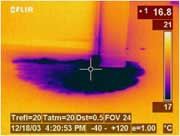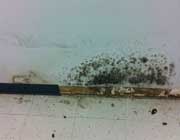Why Mold Test?
There are many valid and valuable reasons to perform mold testing. Here are 10 reasons.
Frequent Questions
Get answers to frequently asked questions about mold with our expertise.
Tool Spotlight: BCAM® Infrared Camera

One of the latest tools Mold Inspectors can use to detect mold "hot spots" in places that cannot be seen easily is the BCAM® infrared camera. This kind of equipment and technology offers the mold inspector a non-invasive means of monitoring and diagnosing the conditions of buildings - providing immediate high-resolution thermal imagery, revealing potential structural and moisture issues, energy efficiency and even rodent or pest discovery. The BCAM® infrared camera features an automatic color alarm alerts yout to moisture-laden areas during building scans which can detect potential areas of mold growth, as well as verify when structures are moisture-free during the drying out process. With the BCAM the Mold Inspector can inspect places that can't be physically reached with moisture meters. The BCAM reveals wet conditions behind surfaces such as: enameled walls and wallpaper that don't readily water stain, track leaks to their source, monitor the drying process, and confirm when a structure is dry. Indoor Air Quality (IAQ) deals with the content of interior air that could affect health and comfort of building occupants. The IAQ may be compromised by microbial contaminants (mold, bacteria), chemicals(such as carbon monoxide,radon}, allergens, or any mass or energy stressor that can induce health effects. Often it is perceived that outdoor air is polluted, but indoor air is acceptable. Scientific studies illustrate the falsity of this perception, and, in fact, indoor air is often a greater health hazard than the corresponding outdoor setting.
Reasons to Test
There are many valid and valuable reasons to perform mold testing. Here are just a few reasons:
1. To establish a baseline for future testing. This allows a mold professional to track and evaluate the progress of mold abatement activities. If the current levels are unknown, it is difficult to establish that progress has been made.
2. To establish the presence of mold and the justification for remediation. Many remediators and insurance companies will not authorize or undertake mold remediation if the presence of mold growth is not scientifically demonstrated.
3. To set the parameters for the remediation. Many remediation companies will not initiate an abatement project without the input of a testing company to define the boundaries of the affected area needing remediation.
4. To identify the types of mold present, i.e. "natural" or "toxic". In many cases, residents are interested in the types of mold present and the possible relation to medical symptoms they may be experiencing. Certain mold species may cause serious illness in the elderly, or in infants; people who have weak immune systems due to chemotherapy or AIDS. Testing can assure the indoor environment is free of mold species that may cause infection in susceptible persons.
5. To find out the levels present. Although mold is mold, and its presence calls for remediation, it is useful to know if the ambient airborne levels are in a range of thousands, or hundreds of thousands. For example, this may affect decisions regarding the timeliness of remediation, and the continued occupancy of the premises.
6. To find "hidden mold". Mold growth may often not be visible in a house, but known water intrusion or a moldy odor provides cause for concern. Testing will identify if there is a mold problem, even when there is no visible mold growth.
7. To "clear" a remediation, that is, to show that all mold is gone after remediation. Often, mold remediation will miss a mold-contaminated area. Testing of the air in the contained work area will assure that the levels inside the work area are reduced to ambient levels. This also provides documentation for future real estate transfers that the mold was properly and effectively removed.
8. To "establish" the lack of mold, as in a home purchase. Sometimes a home buyer will have concerns about mold when purchasing a new home. This may be as a result of a bad experience with mold in their previous residence. Mold testing can provide the peace of mind that there are no problems with elevated airborne mold in the new house.
9. To show that a flood has not yet created mold growth. Floods in homes and offices can occur due to breaks in plumbing lines, or failure of plumbing fixtures. After the cleanup and drying, it is useful to test for mold to assure occupants that mold has not grown as a result of the flooding.
10. To support a legal case. A lawyer or plaintiff usually needs to have objective evidence of the presence or absence of mold and mold exposure to support a legal action. Testing can show scientifically that mold was, or was not, present.
Mold Certifications




Mold Pictures On Our Pinterest! Check Out The ISCT Mold Glossery While You View Our Pinterest!
Don't Let this Happen to You
